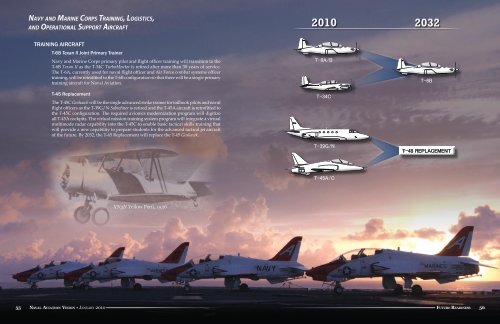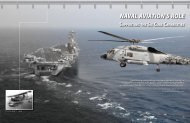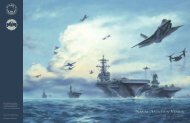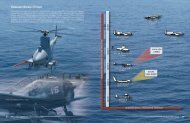training airCraFt - NAE
training airCraFt - NAE
training airCraFt - NAE
Create successful ePaper yourself
Turn your PDF publications into a flip-book with our unique Google optimized e-Paper software.
Na v y a n d Ma r i n e Co r p s Tr a i n i n g, Logistics,<br />
a n d Op e r a t i o n a l Su p p o r t Ai r c r a f t<br />
2010<br />
2032<br />
Training Aircraft<br />
T-6B Texan II Joint Primary Trainer<br />
Navy and Marine Corps primary pilot and flight officer <strong>training</strong> will transition to the<br />
T-6B Texan II as the T-34C TurboMentor is retired after more than 30 years of service.<br />
The T-6A, currently used for naval flight officer and Air Force combat systems officer<br />
<strong>training</strong>, will be retrofitted to the T-6B configuration so that there will be a single primary<br />
<strong>training</strong> aircraft for Naval Aviation.<br />
T-45 Replacement<br />
The T-45C Goshawk will be the single advanced strike trainer for tailhook pilots and naval<br />
flight officers as the T-39G/N Sabreliner is retired and the T-45A aircraft is retrofitted to<br />
the T-45C configuration. The required avionics modernization program will digitize<br />
all T-45A cockpits. The virtual mission <strong>training</strong> system program will integrate a virtual<br />
multimode radar capability into the T-45C to enable basic tactical skills <strong>training</strong> that<br />
will provide a new capability to prepare students for the advanced tactical jet aircraft<br />
of the future. By 2032, the T-45 Replacement will replace the T-45 Goshawk.<br />
T-6A/B<br />
T-34C<br />
T-39G/N<br />
T-6B<br />
T-45A/C<br />
XN3N Yellow Peril, 1936<br />
55 Na va l Aviation Vision • Ja n ua r y 2010<br />
Fu t u r e Readiness 56
T-44 Replacement Aircraft<br />
The T-44A Pegasus and the TC-12B Huron are<br />
both pressurized, twin-engine, fixed-wing<br />
aircraft used to conduct multiengine aircraft<br />
<strong>training</strong> for Navy, Marine Corps, Air Force,<br />
and Coast Guard pilots. Training in the TC-12B<br />
will be discontinued in 2012. The T-44C, which<br />
upgrades the T-44A with a digital cockpit,<br />
will become the single multiengine <strong>training</strong><br />
platform for Naval Aviation. By 2032, the T-44<br />
Replacement will replace the T-44C.<br />
TH-57D Sea Ranger Rotary<br />
and Tilt-Rotor Trainer<br />
The TH-57D Sea Ranger will replace the TH-<br />
57B/C as Naval Aviation’s single rotary-wing<br />
and tilt-rotor aircraft <strong>training</strong> platform. Future<br />
upgrades will include a digital cockpit and<br />
passenger protection to enhance <strong>training</strong> and<br />
safety to match more closely the capabilities of<br />
Navy and Marine Corps fleet helicopter and<br />
tilt-rotor platforms.<br />
2010<br />
T-44A/C<br />
TC-12B<br />
TH-57B/C<br />
2032<br />
TH-57D<br />
57 Na va l Aviation Vision • Ja n ua r y 2010<br />
Fu t u r e Readiness 58
Logistics Aircraft<br />
Nav y-Un i qu e Fleet-Essential Ai r c r af t<br />
Navy-unique fleet-essential aircraft provide Navy combatant commanders with shortnotice,<br />
fast-response, intra-theater logistics support when and where it is needed. Comprised<br />
of several aircraft platforms, these assets deliver medium- and heavy-lift capabilities in<br />
direct support of the fleet worldwide. Designed primarily to provide a reliable and highly<br />
flexible airborne logistics capability for the wartime movement of personnel and heavy<br />
cargo, they respond to immediate demands for the movement of essential fleet personnel<br />
and cargo to mobile sea-based naval force elements.<br />
C-40A Clipper<br />
The C-40A Clipper is a Boeing 737-700 next generation aircraft equipped with an<br />
oversized cargo door that offers multiple passenger and cargo configurations and<br />
combinations. It is replacing the aging C-9 Skytrain and C-20G Gulfstream fleet. The<br />
venerable C-9 has served the fleet exceptionally well for years, but with an average<br />
aircraft age of 36 years, its maintenance costs are steadily rising. The C-40A has increased<br />
range, capacity, and fuel efficiencies to support sea-based logistics.<br />
<br />
2010<br />
C-9B<br />
C-40A<br />
2032<br />
C-40A<br />
KC-130J Hercules<br />
The KC-130J is the follow-on aircraft that will replace the C-130T. With increased<br />
performance, fuel efficiency, and maintenance reliability, the KC-130J is fully compliant<br />
with the Communications Navigation Surveillance/Air Traffic Management System<br />
and comes equipped with an electronic flight deck. Scheduled for delivery in fiscal<br />
year 2017 (to the Navy), this aircraft can transport up to 35,000 pounds of cargo (or 75<br />
passengers) 1,800 nautical miles at 350 knots.<br />
C-20G<br />
C-130T<br />
KC-130J<br />
Ma r in e Co r p s Me d i u m Lift Op e r at i on a l Su p p o rt Airlift<br />
The Marine Corps uses the medium-lift C-9B aircraft for operational support airlift<br />
missions. Marine Aviation will replace the C-9 with the more capable C-40A aircraft. The<br />
Marine Corps C-20G will be replaced by a super mid-sized UC-35 Extended Range (ER)<br />
Replacement.<br />
59 Na va l Aviation Vision • Ja n ua r y 2010<br />
Fu t u r e Readiness 60
Operational Support Aircraft<br />
Operational support aircraft are used to transport high-priority passengers and cargo when<br />
requirements are time-, place-, or mission-sensitive. They are stationed worldwide and perform<br />
critical airlift missions for the geographic combatant commanders to and from remote locations<br />
where commercial sources are not available or viable.<br />
UC-12W Hawker Beechcraft King Air 350<br />
The UC-12W is replacing the Marine Corps UC-12B/F Huron and will provide light-lift<br />
capability through 2032. With a crew of three and a maximum range of 1,900 nautical<br />
miles, the King Air 350 can transport up to eight passengers while flying at a speed of<br />
290 knots at an altitude of 35,000 feet.<br />
UC-35 Extended Range Replacement Cessna Sovereign<br />
The UC-35C/D and C-20G aircraft continue to provide high-speed transport for<br />
time-sensitive passengers and cargo. These aircraft have performed admirably, but<br />
operating forces need a jet transport with increased range and improved passenger<br />
and cargo capabilities. The replacement aircraft will be the UC-35 Extended Range<br />
Replacement aircraft.<br />
C-12 Replacement<br />
A C-12 Replacement aircraft will be identified to replace the Navy’s current fleet of<br />
UC-12B/F/M Huron and C-26D Metroliner aircraft to provide light-lift capability<br />
through 2032.<br />
Executive Transport Aircraft<br />
C-37A/B Gulfstream G550<br />
The C-37A/B Gulfstream executive transport aircraft replaces the aging C-20A/D<br />
to provide senior Navy Department personnel with high-speed, long-range<br />
transportation with a secure communications capability. Flying at speeds up to 585<br />
knots, the G550 can travel 6,750 nautical miles at 45,000 feet and transport 12 or 14<br />
passengers depending on configuration.<br />
2010<br />
UC-12B/F<br />
UC-35C/D<br />
C-20G<br />
UC-12B/F/M<br />
C-26D<br />
C-20A/D<br />
C-37A/B<br />
2032<br />
UC-12W<br />
UC-35ER<br />
C-37A/B<br />
61 Na va l Aviation Vision • Ja n ua r y 2010<br />
Fu t u r e Readiness 62
Other Naval Aircraft<br />
E-6B Mercury Airborne Command Post<br />
Derived from Boeing’s 707 aircraft, the E-6B supports Commander, U.S. Strategic<br />
Command, with the command, control, and communications capabilities needed to<br />
direct and employ strategic forces. Designed to support a flexible nuclear deterrent<br />
posture, the E-6B performs very-low-frequency emergency communications, U.S.<br />
Strategic Command airborne command post missions, and airborne launch control<br />
of ground-based intercontinental ballistic missiles. The Block I program, (initial<br />
operational capability in 2013), is designed to improve the mission communication<br />
systems of the aircraft and increase efficiencies between airborne command post<br />
and Navy communications personnel. The internet protocol/bandwidth expansion<br />
program (2013) and the Block II program (2015) both provide increases in line-of-sight<br />
and satellite-based data links to allow for greater data throughput supporting highcapacity<br />
communications. The service life extension program (2011) ensures continued<br />
airframe viability well into the 21 st century.<br />
2010<br />
E-6B<br />
2032<br />
63 Na va l Aviation Vision • Ja n ua r y 2010<br />
Fu t u r e Readiness 64
C-2A Greyhound/Future Carrier Onboard Delivery Aircraft<br />
The C-2A Greyhound transports high-priority cargo, mail, and passengers between<br />
carriers and shore bases. It can deliver a combined payload of 10,000 pounds a distance<br />
of 1,000 nautical miles, and its interior cabin can be rearranged easily to accommodate<br />
passengers, litter patients, or jet engines. The large cargo ramp at the rear of the aircraft<br />
and a powered winch allow straight-in rear loading and unloading for fast turnaround<br />
and can be operated in flight to air drop supplies and personnel. Equipped with an<br />
auxiliary power unit used for unassisted engine starts, the Greyhound can operate<br />
independently from remote locations, adding to its operational versatility. The aircraft<br />
is currently undergoing several modifications and a service life extension program,<br />
which include structural enhancements, improvements to the avionics system, rewiring,<br />
and a new propeller system that will extend the Greyhound’s service life until a Future<br />
Carrier Onboard Delivery Aircraft can be fielded.<br />
VXX Replacement Presidential Helicopter<br />
A replacement is under development for the 30-year-old VH-3D and 20-year-old VH-60N<br />
helicopters, currently providing transportation for the President of the United States,<br />
foreign heads of state, and other dignitaries as directed by the White House Military<br />
Office. The Replacement Presidential Helicopter (VXX) will provide a hardened, mobile<br />
command-and-control transportation capability and a system of integrated systems<br />
necessary to meet current and future presidential transport mission requirements.<br />
2010<br />
C-2A<br />
VH-3D<br />
VH-60N<br />
2032<br />
65 Na va l Aviation Vision • Ja n ua r y 2010<br />
Fu t u r e Readiness 66






